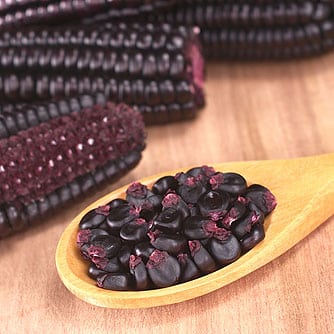Diabetic nephropathy is one of the most serious complications related to diabetes, often leading to end-stage kidney disease. Purple corn grown in Peru and Chile is a relative of blue corn, and the maize is rich in anthocyanins – antioxidant compounds that are reported to have anti-diabetic properties. Scientists from Hallym University (Korea) investigated the cellular and molecular activity of purple corn anthocyanins, performed a two-part study, an in vitro experiment investigating the effects of purple corn anthocyanins on human endothelial cells cultured under hyperglycemic kidney conditions and an in vivo study that investigated the effects of purple corn anthocyanins on kidney tissue in diabetic mice. The team found that in human endothelial cells cultured in hyperglycemic kidney conditions, induction of endothelial cell adhesion molecules decreased in a dose-dependent manner with purple corn anthocyanins exposure, meaning that the purple corn anthocyanins likely interfered with cell-cell adhesion in glomeruli. purple corn anthocyanins also appeared to interfere with leukocyte recruitment and adhesion to glomerular endothelial cells. In diabetic mice, purple corn anthocyanins exposure slowed mesangial expansion and interrupted the cellular signaling pathway that may instigate glomerular adhesion and infiltration of inflammatory cells responsible for diabetic glomerulosclerosis. Finally, purple corn anthocyanins inhibited levels of macrophage inflammatory protein-2 and monocyte chemotactic protein-1 in kidney tissue, demonstrating that it may inhibit macrophage infiltration, which is closely related to renal inflammation. The research suggests that anthocyanins may be the main biofunctional compound in purple corn and could protect against mesangial activation of monocytes and infiltration of macrophages in glomeruli—the two major contributors to diabetic nephropathy. The research further suggests that renoprotection by purple corn anthocyanins against mesangial activation may be specific therapies targeting diabetes-associated diabetic glomerulosclerosis and renal inflammation. The study authors conclude that: “[Purple corn anthocyanins] supplementation would be an important strategy for preventing renal vascular diseases in type 2 diabetes.”
Purple Corn Compound Helps to Slow Kidney Damage
Min-Kyung Kang, Jing Li, Jung-Lye Kim, Ju-Hyun Gong, Su-Nam Kwak, Jung Han Yoon Park, et al. “Purple corn anthocyanins inhibit diabetes-associated glomerular monocyte activation and macrophage infiltration.” American Journal of Physiology – Renal Physiology, July 11, 2012.
RELATED ARTICLES




